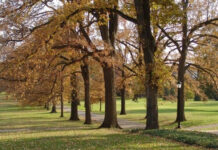Will we see the same record numbers as 2021?
The turf world is a constantly changing environment and being really good at what you do also requires change. Over time, our approach to turf management has evolved and practices have been modified. Changes in weather patterns and climate further complicate matters.
I will avoid spending a lot of time on this topic to avoid alienating anyone, but from my perspective, climate change is very real. We can measure it, see it, and it is reflected in our pest problems.
When I first started at North Carolina State University, sod webworms on bermudagrass were a problem. Through the late ‘80s, though, I never really saw webworm problems and rarely received any calls. However, in the past few years, sod webworms seem to be returning. (For advice, see content.ces.ncsu.edu/sod-webworm-in-turf.)

As drought conditions worsen in some areas, it could impact insects that like it hot and dry—such as southern chinch bugs and bermudagrass mites—which may increase dramatically. Others that require soil moisture for egg laying, such as white grubs, may become less abundant. This can also vary annually depending upon weather. Pest problems we’re seeing throughout the country, in both warm and cool-season turf, are not consistent, but things are ultimately changing.
Pest Trends
So what transitions in insect pest populations have I observed in the past few years? I could start with an ever expanding range of fire ants, more chinch bug problems, new white grub species, more bill- bugs, annual bluegrass weevil expansion, mites, and in 2021 – fall armyworms. We also have seen strange outbreaks including sugarcane beetles that cause problems for two to three years and then go away.
Many factors allow or promote these pest changes. In some cases, invasive pests are simply adapting and expanding their range. It may also be the result of changing turf and landscape management practices that create more favorable conditions. Finally, it could be related to transitions to warm-season turf types and climate warming (fall armyworm). It isn’t as simple as outlined here, but pest changes are happening and we have ways to manage them. All turfgrass insect pests can be effectively managed (except ground pearls), but awareness, monitoring, and timely applications of proper products are the key to success.
While chinch bugs, billbugs, mites, and others have increased in abundance and frequency in recent years, I want to focus on one observed at record levels last year: fall armyworms. They occurred in locations where no one had ever experienced them before. Once the battle was over, everyone was asking: Why did it happen and was it going to happen again in 2022?
Fall Armyworms
First, let’s take a look at fall armyworm biology. They do not overwinter in the majority of the U.S. They are tropical insects that overwinter in extreme southern Texas, along the Gulf Coast. Therefore, any infestations outside of these warmer areas must start all over again annually with the migration of moths to the North. In other words, what happened in 2021 is going to have very little impact on 2022. Any given year’s outbreak is dependent upon the northward migration—and that migration is impacted by weather. I have seen moths arrive in NC and start causing problems as early as May and as late as July. The timing of their arrival impacts the potential for serious outbreaks. In fact, in some years, outbreaks in NC don’t occur until late August.
Fall armyworm outbreaks are always sporadic—even in NC where we see our fair share. However, it appears we are seeing more and more each year as compared to 10-20 years ago. In my area of NC, they are more problematic on hybrid Bermuda, but I have seen them cause serious damage in both warm and cool-season turfgrass.
It’s important to know that fall armyworms that overwinter in Texas are not identical to the ones that overwinter in Florida. These “strains” differ a bit in their host preference. The Florida strain prefers Bermuda and the Texas strain is happy feeding on tall fescue. There is a lot we are still learning about fall armyworms, but we do know they are a challenge to manage.
When fall armyworm moths arrive in an area, they mate and lay eggs. Unlike many moths of turf pest species, such as sod web- worms and cutworms, fall armyworm moths seldom lay eggs on the turfgrass. Rather, they lay eggs on “objects,” like the side of a house, fence, shrub, soccer goal post, or even a flag. The small larvae hatch from eggs and drop down to begin feeding on nearby turf.
In the first two or three weeks of feeding, turf damage is typically not noticed since the larvae are too small to cause issues. But once they grow larger, damage can be quite serious and all turf can be consumed. Since eggs are usually laid near the turf edge, or from a structure or shrub, almost every infestation shows damage that “moves” out from the origin point. As armyworms get larger, they “march” across turf, creating a distinct line between damaged and undamaged turf. Once development is complete, they pupate in the soil to emerge as a moth in about seven to 10 days. In my experience, this next generation of moths does not necessarily contribute to another outbreak of a new infestation in the same location.
Monitor With Soapy Water Flush
- Fill a container with one to two gallons of water. Add one to two tablespoons of lemon-scented liquid dish detergent. (When using on bentgrass, dilute the rate further.)
- Mix by hand until soap suds appear.
- Slowly pour the soap mixture over one square yard of turf-grass. Perform the flush on healthy turfgrass adjacent to damaged areas. (Insects are less likely to be found in heavily-damaged turfgrass. They have eaten and moved on.)
- Watch closely for five to 10 minutes for insects to emerge.
Repeat applications in different areas may be necessary to gain full understanding of the armyworm’s population density. The flush also works for:
- Annual bluegrass weevil (adults)
- Black turfgrass ataenius (adults)
- Bluegrass billbug (adults)
- Chinch bugs (nymphs & adults)
- Cutworms (larvae)
- Mole crickets (nymphs & adults)
- Tropical/Sod webworms (larvae)
—North Carolina State University
Armyworm caterpillars live for three to four weeks, depending on temperature, and it’s in the last the week they do the most damage. Since this pest is sporadic and causes limited damage when small, damage seems to appear overnight. Yet the sooner you find and manage infestations, the more cost-effective your effort will be. The soapy water flush (below) is the most effective monitoring technique for mobile insects in thatch, leafy areas, and the soil profile. Soap irritates them, forcing a move to the surface. Pyrethroids work well against small caterpillars, but larger ones are harder to control and may require more expensive options. Some of the more commonly used and highly effective options include Provaunt, Acelepryn, and Tetrino.
Fall Forecast
Why are fall armyworms becoming more of an issue and why did we see such problems in 2021? In NC, I think the abundance of bermudagrass is a big factor. As mentioned, armyworms from Florida love it. Populations from other areas, such as Texas, do well on cool-season grasses and we saw a lot of problems on tall fescue in the Midwest and Northeast as migrating moths swept into areas such as Pennsylvania. It was a perfect storm for dispersing moths northward, and establishment once they arrived. People have asked if climate change is allowing the armyworms to overwinter further north. It could be, but at this time, I think it’s not an important factor. I think 2021 was just one of those years.
What is going to happen in 2022? Are we going to see major armyworm outbreaks again? I doubt we will see a 2021 repeat, but I make that statement with a limited database. I know at the time of this writing in late July, we are seeing armyworm moths already.
The first records of them were earlier than normal which could mean above-normal problems. A dry year can also mean serious problems as they tend to migrate towards irrigated turf. August and September are typically the worst months. The key is to stay up to date with regional trends. I post a lot about fall armyworm on my facebook page, Turf, Bugs, and Rock n Roll. Ask to become a member and I will add you.
Insect pest populations are changing just as they always have. Perhaps that change is a bit more frequent than in the past. We need to stay educated and alert through extension services or social media outlets. Bob Dylan had it correct: “The Times They Are A-Changin.” Good luck in Fall 2022!
 Dr. Brandenburg is a William Neal Reynolds Professor of Distinction in entomology at North Carolina State University. His research and educational programs focus on developing a sound understanding of pest biology and ecology as well as ecologically and environmentally sound turfgrass insect pest management programs. These include cultural practices and biological control, as well as techniques to forecast pest outbreaks. He provides advice on his popular 2.7K-member facebook page: Turf, Bugs, and Rock n’ Roll.
Dr. Brandenburg is a William Neal Reynolds Professor of Distinction in entomology at North Carolina State University. His research and educational programs focus on developing a sound understanding of pest biology and ecology as well as ecologically and environmentally sound turfgrass insect pest management programs. These include cultural practices and biological control, as well as techniques to forecast pest outbreaks. He provides advice on his popular 2.7K-member facebook page: Turf, Bugs, and Rock n’ Roll.
Do you have a comment? Share your thoughts in the Comments section below, or send an e-mail to the Editor at cmenapace@groupc.com.











![[VIDEO] Dickies®: Discover Workwear That’s Anything But Uniform](https://turfmagazine.com/wp-content/uploads/2023/06/1647663814-4b1a2a7742790a9b1e97a3b963477850192e1d6a9dfba9b07214a77bae25d6e3-d-218x150.jpg)




























![[VIDEO] Dickies®: Discover Workwear That’s Anything But Uniform](https://turfmagazine.com/wp-content/uploads/2023/06/1647663814-4b1a2a7742790a9b1e97a3b963477850192e1d6a9dfba9b07214a77bae25d6e3-d-324x160.jpg)
Not sure about “climate change” causing the variations of insects, moth, grubs, etc. Northern Minnesota has dealt with major army worm invasions for decades. Enough to carpet the roads and make them slippery. As Earth is a live and active planet, some changes in patterns of weather and climate are expected over time. This does not form a conclusion that mankind is responsible.